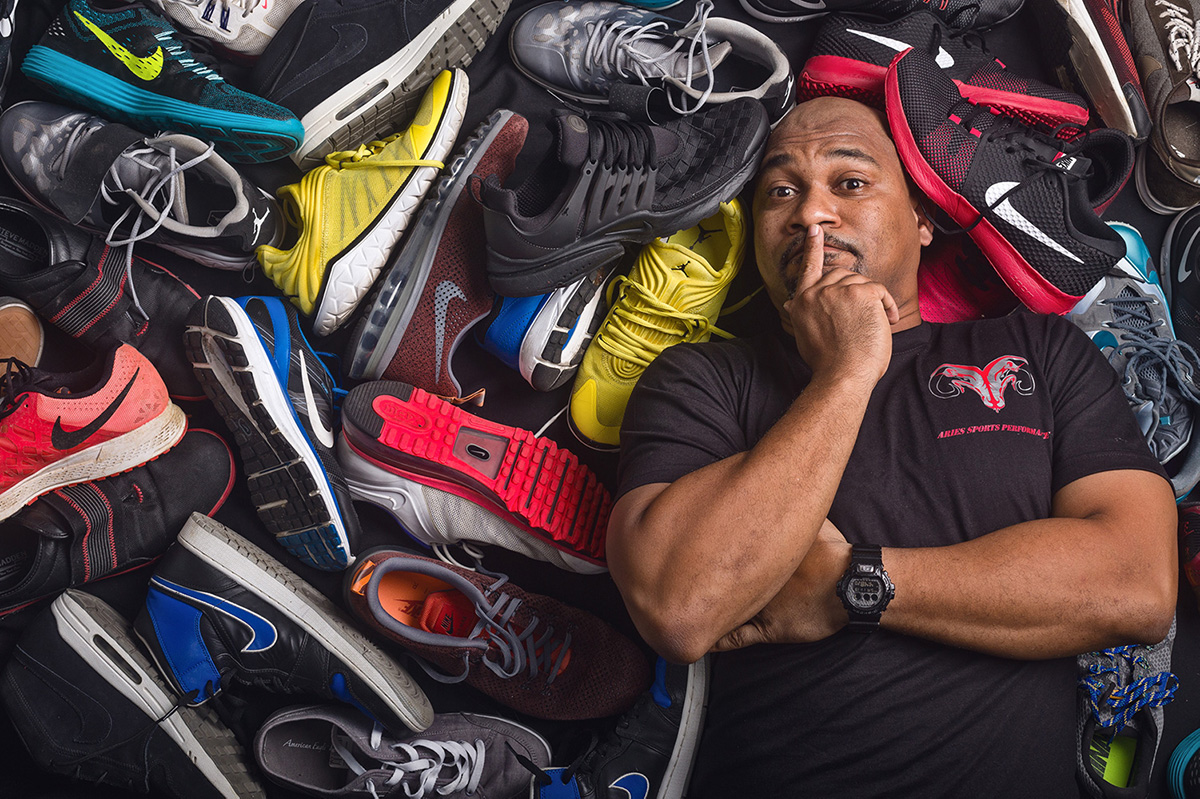


First, most of us make the mistake of using running shoes for most of our training. Running shoes are designed for forward motion, and not entirely designed for multidirectional training like at the gym, during aerobics, Zumba, Cross-Fit and or outdoor cross training activities. Running shoes are designed for a heel to toe action like jogging, running and walking. Running shoes may seem to be a better investment because they last longer due to the cushioning but you can easily roll an ankle while trying to change direction in them, so if you’re going to be at the gym choose cross-trainers instead. Telling the differences between a running shoe and a cross- trainer is simple. A cross-trainer has a wider sole; often wider than the upper part of the shoe. The width provides stability and support when changing direction and moving laterally. Another difference is the traction between the two. The running shoe has threading that is a little smoother and the lines may run across the length of the shoe showing direction from front to back. The traction of the cross-trainer may be more pronounced for gripping when changing direction respectively.
Now that we’ve had a clearer understanding between the differences let us also learn a little about the biomechanics of the foot to ensure you’re comfortable while on the move. To know what type of feet you have one should seek out a professional in orthopaedics or a professional in the sports medicine field to determine where is the wear and tear happening and how it can affect you long term. You can also try an inexpensive method by actually looking at your old sneakers and observe where it’s been worn, this will tell you what sort of feet you have. Check to see if you have a Neutral foot, if you’re a Supinator or Pronator.
“Supinators” are those folks who tend to have high arches. Their shoes are worn on the lateral or outer side of their shoes from the heel to baby toe. It is advised that they should acquire orthotic shoe inserts for arch support. For Pronators or people with lower arches, their shoes are worn on the medial side; around the ball of the foot near the big toe and inner heel, they’ll need to get sneakers that provide a little more cushioning for shock absorption because how their feet land can affect the joints higher up the kinetic chain.
Generally you can tell without even looking at their feet. I look at their inner ankles; how it collapses the inside of their shoes, especially if it doesn’t have any arch support. Another possible tell-tale sign is looking at their knees; locally we say those folk have “knock knees” or “K-Foot” where their knees don’t line up straight under the hips but sort of dive in creating a smaller area of support.
These people need Motion-control or greater arch support to better align their feet with their legs. When looking for these shoes look for a significantly padded or reinforced arch in the shoe. They might look a little bulky but they feel great and you’ll notice a difference in them as soon as you begin to move around in them.
For my overweight friends I’ll suggest that you also source shoes for pronators as well. You’ll need much more stability and cushioning from the impact due to the extra weight. You too will find the ride fantastic.
If you have neutral feet, there is equal wear distributed across the length of the shoe; from outside heel to more or less the middle of the shoe. You still should source a shoe with moderate stability which will give support and cushioning. Look for something flexible at the balls of the feet and lightweight. Generally those who have neutral feet have the freedom to wear whichever sneaker that feels great to them.
So we’ve gone past what’s good for your feet to now when should you retire those sneakers. I totally understand that you love your sneakers, you’ve had to look far and wide for the right pair, they don’t make them like the one you have and that you’ve fallen madly in love with them but please understand that the relationship between them and your feet is over! Those of you who are in denial will go far as washing them to make them look new again so you can spend some more time with them but again it’s over.
Shin splints - tiny micro tears within the fascia and muscle tissue that run along the tibia bone causing pain. This occurs because the shock absorption in your sneakers has run its course and has naturally deteriorated caused by your pounding of the pavement.
Knee pain - again, the shock absorption in your sneakers is gone but you’re still going along with the program. The pain can be worse for those who are trying to lose weight. Training with extra weight can be brutal, therefore causing more harm than good. If you’re beginning a program or if you’re transitioning into higher intensity training seek to make a change or an upgrade to better cushioning.
Foot pain and sore arches - those with flat feet and low arches are vulnerable to this problem. Very few sneaker merchants know what’s best for their customers and usually sell what looks good and not address the issue of low arches or flat feet. Continuing to run with old sneakers whose arch support has weakened is asking for stress fractures and other serious problems with your feet.
When they stink - that sort of goes without saying. You can put your feet in a lot of problems where foot fungus can make things pretty uncomfortable for not just you, but for all who have to be around your smelly feet.